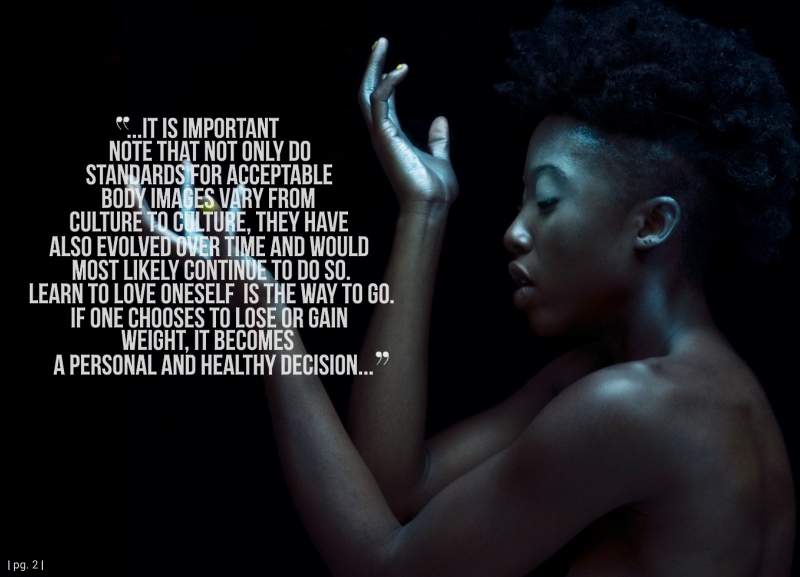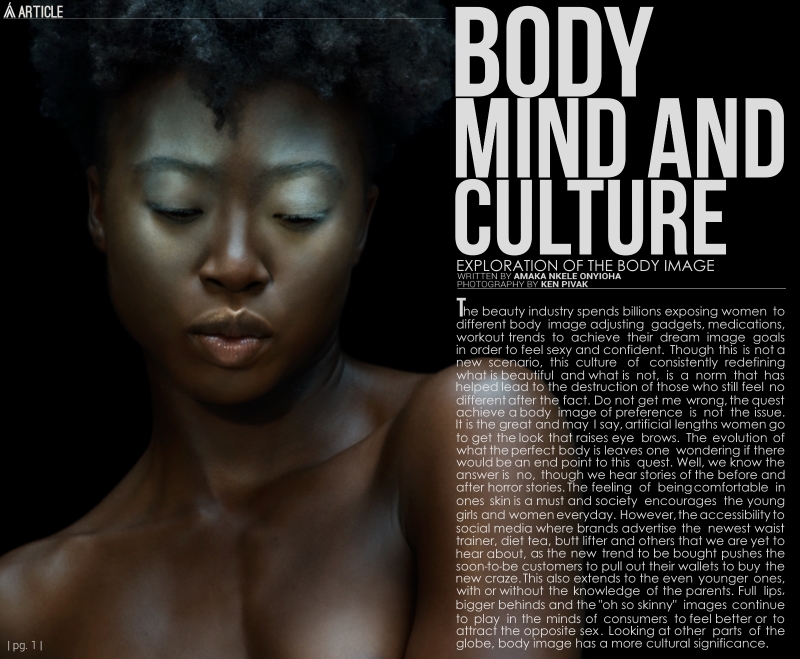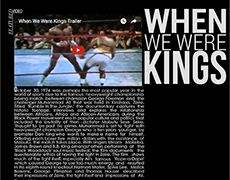Body image is a person's perception of the aesthetics or sexual attractiveness of their own body. Human society has at all times placed great value on beauty of the human body, but a person's perception of their own body may not correspond to society's standards. The idea of body image is thought to be a product of one’s personal experiences, personality, and various social and cultural norms. A person's sense of their own physical appearance, usually in relation to others or to some cultural "ideal," can shape their body image. A person's perception of their appearance can be different from how others actually perceive them. To many of us, it may seem that certain standards of beauty of either being at a certain weight and size reflect an objective reality. And when it is continuously placed in front of us through all from of media, it becomes an accepted false reality. I got to thinking about society’s idea of body image in comparison to cultural standards of beauty image. Cultural standards are said to be unique and differ from one another around the globe and seen as harmless and healthier expectations that were created by those who when before us – our ancestors and so should be respected and adhered. But in this day an age of technology, entertainment, fashion and the different forms of media, are cultural ideals of body image just added pressures to an individual who wants to appease his or her tradition while answering to the expectations of society?
In some parts of Africa, happiness and wealth are regarded as important factors related to body image. It is the belief that being heavier means one is happy and when happy one lets go; thus letting the happiness show physically. Also, linked to wealth, body image is believed in parts of Western and Southern Africa that a weight of a man automatically speaks to his financial wealth. The heavier he is, the more wealth he has; and the thinner he looks, the lack of success he has. This idea spills over in connection to marriage in that the women are encouraged to be heavy or to become heavier as they prepare to be married into the new family. This requirement is also to show that a wife is well taken care of. For example, the Efik people of Nigeria are said to send their women to fattening rooms in preparation for marriage. There, they are fed large amounts of food, massaged and made to sleep for long periods of time in an effort to increase their weight and gain fuller proportions. Efik women (and men) take great pride in this time-honored tradition of fattening brides before marriage. It is that high in priority that there are said to be instances where a lady can be refused by a fiancé’s family because the body image does not fit proper ideals of curvy, heavier bride. So clearly, being skinny is not a universal standard of beauty in this circumstance. The idea of thinness where the body has little fat is tends to be related to being ill and thus wasting away.

Though there is the acceptability to being curvier and heavier in other countries outside of Africa or being naturally slim according to the traditional norms, there is still the defenselessness of being looked over when there is a hair out of place. The weight patrol comes out and it is off to the races on what has grown bigger and what should grow smaller. As I researched for this article online, I came across some writers of different races and cultural backgrounds from Taiwan, China to Mexico and Italy, who all noted the same idea from different situations – there is the constant barrage of questions by family members on why they are heavier or thinner than the last time they saw each other – even if there may not be much of a big difference in the way they look. Nevertheless, the ladies (and some men), come up with one story or the other. Though the questioning maybe just a concern or to possibly a way to start up a conversation as weird as that may seem, they each in their own way felt uncomfortable having to talk about their bodies. A feeling that no matter the background, there is the pressure to be slim or heavy seems to cut across the board. Even now in parts of Africa, though the drive to be slim is not prioritized as much, the modeling and entertainment industry plays a role for those looking to be discovered for superstardom. The motivation to be perfect is a major reason that an aspiring model would look for ways to stay trim-even though they are already there. Cultural and traditional standard of the right body image I would say is not a prime focus in comparison to two or three generations past.
So after all is said and done, it is important to note that not only do standards for acceptable body images vary from culture to culture, they have also evolved over time and would most likely continue to do so. The important point here is that whatever we see as ideal beauty or body image is arbitrary. There is no objective standard of physical attractiveness and the perfect body image. Someone who may be considered heavy in the North America or Asia may be seen as having the ideal body type in Africa, Europe or South America. The same body type that is in one decade can end up no longer being the norm in the next; but then it makes a comeback a few years later. In my opinion, being happy with how one looks is not to try to adjust ones weight to go up or go down. Instead, learn to love oneself is the way to go. In so doing, if one chooses to lose or gain weight, it becomes a personal and healthy decision. It is a healthy decision that is based on one’s emotional, spiritual and mental journey that eventually led to the decision. Remember that none of our cultural beauty standards are based on any kind of real truth, so there is no point in trying to conform to them. At the end of the day, we all have different bodies, and they are all completely beautiful, just as they are – as it should be.




